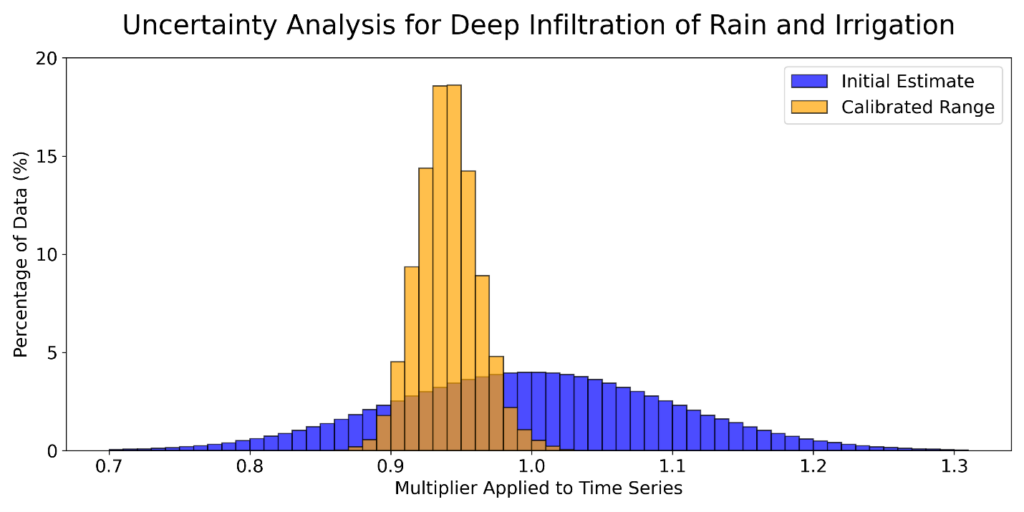To Uncertainty and Beyond! Addressing Uncertainty in Groundwater Modeling

By Garrett Rapp, PE, Senior Engineer
This article contains and answers the following:
What is uncertainty analysis, and why is it important in groundwater modeling?
How does uncertainty analysis enhance groundwater model reliability?
What practical benefits does uncertainty analysis provide?
- Groundwater modeling
- Uncertainty analysis
- Groundwater management
- Groundwater recharge
- Safe Yield
- Environmental systems
Groundwater holds its secrets tightly hidden. Throughout my career in water resources consulting and management, my mission has been to uncover the mysteries of groundwater and develop better ways to manage this precious resource. Since we can’t directly observe groundwater, how do we determine where it is, how it moves, or how much is available? In lieu of a Jules Verne-inspired journey underground, managers often rely on computer models to answer these critical questions.
Groundwater modeling is a powerful tool for understanding unseen water systems and making informed management decisions. With advances in computing, we can now simulate groundwater flow on massive scales and generate highly accurate forecasts. Yet with this power comes responsibility. Modeling requires assumptions based on available data and experience. The best modelers continually test these assumptions, seeking out their limitations and improving their tools. Modern methods, like uncertainty analysis, help us ask deeper questions: How do unknowns affect our decisions? Where should we monitor to improve understanding? What risks arise from what we don’t know?
The World of Uncertainty Analysis
Groundwater models rely on parameters—values that represent factors like rainfall, streamflow, pumping rates, and geologic properties. These values are often imperfect, introducing uncertainty about the underground environment. To account for this, we use uncertainty analysis, a process that generates multiple combinations of parameters that fit observed data, allowing us to explore how different assumptions impact model outcomes. This involves systematically adjusting parameters within plausible ranges and assessing how well each combination aligns with real-world measurements.
“Modern methods, like uncertainty analysis, help us ask deeper questions: How do unknowns affect our decisions? Where should we monitor to improve understanding? What risks arise from what we don’t know?”
For example, if part of an aquifer’s geology is unknown, we might base assumptions on nearby areas but allow for wide variability. Similarly, we can account for uncertainty in the observed data itself by creating plausible variants. This approach helps us understand the range of possibilities and make more robust decisions. Modern software, much of which is open source and widely accessible, automates this process, making it easier to explore uncertainty.
Case Study: Chino Basin
We recently applied uncertainty analysis to better understand the large urban Chino Basin, east of Los Angeles. Adjudicated since 1978, the Basin has defined groundwater rights and a Safe Yield—the estimated sustainable pumping limit. Since the 2000s, the Chino Basin Watermaster has used a groundwater model to simulate conditions and adjust the Safe Yield as the Basin evolves.
As part of a model update, we ran an uncertainty analysis during calibration. Estimating deep infiltration of rain and irrigation—key recharge sources—is challenging due to diverse land uses, variable geology, and human impacts. We used a detailed surface-water model to estimate historical recharge, then allowed the groundwater model to adjust these estimates within a realistic range. This helped the model better match observed groundwater levels and streamflow.
“[The results of our uncertainty analysis] prompted us to refine how we represent basin recharge, offering new insights into the basin’s behavior and increasing confidence in the model’s performance.”
Figure 1 shows how our initial deep infiltration estimates compare with the distribution from over 300 calibrated models. Interestingly, the calibrated results (represented by the orange bars) indicate that deep infiltration is about six percent lower on average than we initially estimated. Additionally, these results show less variability, suggesting that the estimates are more certain. These findings prompted us to refine how we represent basin recharge, offering new insights into the basin’s behavior and increasing confidence in the model’s performance.

Looking ahead, we’re applying this approach to explore future uncertainties, like how climate change and water use trends might impact the Basin. These insights will help guide the Basin toward sustainability and set a more robust Safe Yield.
Uncertainty analyses are quickly becoming indispensable as a tool to understand the complex environmental systems we depend on. It helps us improve models, uncover blind spots, and make better decisions. As we keep refining these tools, we’ll be better equipped to help our clients tackle groundwater management challenges and uncover the mysteries beneath.
By Garrett Rapp, PE, Senior Engineer

Garrett Rapp is dedicated to using his expertise in water resources management to ensure sustainable water supplies for all. He excels in surface and groundwater hydrology and hydraulics, leveraging advanced computer modeling and software development. Garrett designs innovative aquifer storage and recovery programs and collaborates with diverse stakeholders on groundwater management plans. He ensures regulatory compliance, monitors water quality, and assesses the impacts of recycled water discharge.
